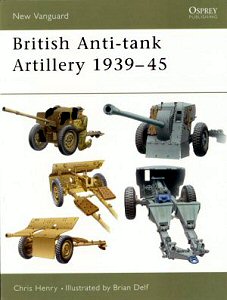
 British
Anti-tank Artillery 1939-45
British
Anti-tank Artillery 1939-45
Osprey New Vanguard 98
By Chris Henry
Illustrated by Brian Delf
Published by Osprey Publishing.
Soft cover, 48 pages
ISBN 1-84176-638-0
Review by Peter Brown
With relatively few books covering artillery, a new one is to be welcomed. This
one deals with British anti-tank guns during the Second World War, when guns
were improved almost beyond recognition in response to the ever-increasing armour
protection of their main targets. They went from a 40mm 2pdr gun which, despite
bad reports, was a good enough weapon at the start of the conflict via a 57mm
6pdr introduced in 1942 to a 76mm 17pdr which appeared in early 1943 and which
with the introduction of new APDS ammunition was capable of taking on the heaviest
German tanks until the end of the war. Along the way there were a French 25mm
and a Swedish 37mm used in small numbers, and a proposed massive 94mm 32pdr which
was the high point of the conventional anti-tank gun in British service before
designs moved to recoilless and later missile systems. Another trend was the
use of self-propelled guns, first by carrying guns on trucks in such as way that
they could be fired from them and later with specially designed tracked armoured
carriers.
The account here follows the design and basic technical descriptions of all
these guns, though the coverage does seem rushed and surprisingly does not
include details of the performance of each type. Neither does it give firm
details of when each new design came into use, or when older designs were phased
out. Photographic coverage is also got the best in print, many photos are grainy
and several have sections cropped off so some details are lost. Best coverage
is given to the French 25mm used only in France in 1940 and the 32pr which
never saw action. Details of self-propelled guns also contains some factual
errors, with old legends such as the "Wolverine" and British use
of the M10A1 being repeated. Areas such as tactics and organisation as well
as towing vehicles are not covered in great depth, and apart from a few hints
the post-war use of several guns is not mentioned.
Overall this is best regarded as a primer, added to the small but important
errors in detail as well as the omissions it is an opportunity lost. However,
with so little on the subject it may well be worth adding to your bookshelf.
Page created 4 November 2004
Click Browsers BACK button to return to list
Home / Book Reviews /
Osprey Publishing


 British
Anti-tank Artillery 1939-45
British
Anti-tank Artillery 1939-45